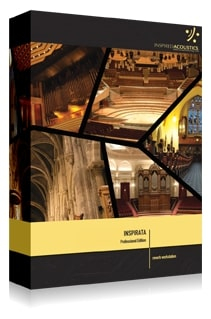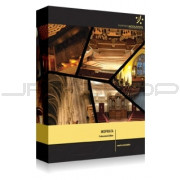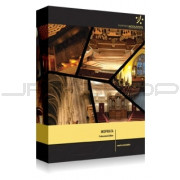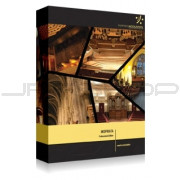You're currently on:
INSPIRATA
INSPIRATA™ is the ultimate next-generation immersive reverb workstation providing you total acoustic freedom. With INSPIRATA, you can:
Choose from a wide variety of real, acoustic spaces sampled in unprecedented detail. Iconic concert halls, theatres, places of worship, simple and natural domestic spaces and unique venues for postproduction.
Move around your sound sources and listener position in the selected space until finding the sweet spot for your mix. Work as if you were physically in that room, positioning the sound sources, or instruments, where you want, and listen from where you want.
Adjust real acoustic parameters that define the acoustic properties of a space and that truly matter to our hearing.
Choose from a massive list of surround mix options up to 22.2, including Dolby Atmos® (available configurations vary between different Editions of INSPIRATA™).
Place multiple sound sources in the selected space (maximum number varies between different Editions of INSPIRATA™)
Automate parameters and even microphone and sound source positions in real time with smooth and artifact-free operation.
INSPIRATA™ comes in AAX, VST3 and AU plugin formats supporting all major DAWs.
Features
INSPIRATA™ is the culmination of many years of research and development by practicing acoustic consultants. The goal was to create a shockingly realistic and immersive sound experience that included tools and measurements previously only taken into account by acoustic professionals. From those years of research, data evaluation and testing comes INSPIRATA, the ultimate next-generation reverb workstation.
Details
Vast content library for music and post production
From the pristine sounds of historic spaces, lush reverberant environments of medieval cathedrals to legendary music clubs, INSPIRATA comes with a growing library of real space content. Many are available for the first time in history and many of them have never been experienced in such detail.
Limitless positioning, smooth movement
Moving virtual sound sources on stage or adjusting the listener position using a sample-based reverb processor was not possible without limitations, until now. In a musical context, now you can move your sound sources and listener to find the optimum recording and mixing locations. Move an instrument slightly backwards on stage for a better balance, or move it closer for more clarity.
In post-production you can use INSPIRATA to automate the movement of your sound sources in every space, from close to far, left to right, as well as any of the acoustical parameters. The sound will instantly follow and sound the same as if you were in the space - only without the environmental noise. This unprecedented feature makes INSPIRATA a true workstation for spatial sound.
Revolutionary spatial controls
In INSPIRATA, we make it possible for you to control parameters that really matter to your ears - you can directly adjust acoustics and the sound of the space instead of the indirect properties that have no change to the sound. Gone is the time when you needed to bother with hall size, wall diffusion or decorrelation only to get different results in each space. You now have full and independent control on how wide your sound source is in the space, how much of the blended sound reaches you, and how much it envelopes around your ears. Spatial room acoustical parameters such as apparent source sound width (ASW) and listener envelopment (LEV) are controllable for the first time directly in any reverberation solution. In addition to these revolutionary controls, you can also adjust the orientation of your speaker feeds in space - facing your stereo or surround setup to any direction. And you can change and automate all of these in real time.
Direct control of sound clarity
In INSPIRATA, reverberation time and sound clarity are adjustable independently, in each space, using a single dedicated control for each. Despite these parameters not being totally independent, INSPIRATA pushes the limits and optimizes the reflections one-by-one to match the desired settings. The basis of the method of changing sound clarity (C80) has been published in an award-winning research paper by our team, and for the first time, it is now available in a real-time implementation.
Controls of the reverberation time
Reverberation time, the mother of all acoustic parameters, is an important aspect of how long the decay lasts. But there is no single reverberation time in a hall, and no single number at a given frequency. In natural spaces, the reverberation time varies slightly location-by-location, and this is fully preserved in INSPIRATA. Not only is the variation reproduced to accuracy, but also the non-exponential nature of the decay of natural spaces to a dynamic range fully covering the theoretical possibilities of sound reproduction.
In real spaces, there is not only a spatial but also a frequency dependency of the reverberation time. Deep tones usually reverberate for a longer time while higher-pitched sounds fade away more promptly – due to, for example, the absorption of the sound of the air in large volumes. The frequency-dependent nature of the reverberation time directly affects the overall tonal footprint of your sound. By using intuitive controls for setting the reverberation time in a frequency-dependent nature or by tilting the controls to be more bass or treble-heavy, you can fine-tune how the space matches your mix with just a few clicks and achieve a level of warmth or brightness otherwise unimaginable.
Surround Support
INSPIRATA supports multi-channel audio by design. With INSPIRATA you can upmix your mono sound source to a wide variety of 3D surround configurations. The upmixing is done by the natural acoustic space itself. You can apply reverberation to surround audio or multi-channel audio for instruments or instrument groups, and deliver in any surround format that you desire with just a few single clicks.
Compatibility
INSPIRATA supports AAX, VST3 and AU formats supporting all major DAWs.
Editions
INSPIRATA™ comes in four editions with distinct feature sets to offer solutions for different needs.
INSPIRATA™ Lite Edition is the most simple and easy-to-use version. A stereo reverb workstation which includes a 9 GB room content library of sampled spaces.
INSPIRATA™ Personal Edition is a stereo reverb workstation providing flexibility never before seen in sampled reverbs. It allows the user to truly finetune the parameters and position the sound sources and the listener in the selected space. The size of the default room content library is 135 GB.
INSPIRATA™ Professional Edition is an immersive reverb workstation with an extended feature set, providing flexibility never before seen in sampled reverbs. Its truly exceptional feature set includes the possibility of finetuning parameters, and positioning the sound sources and the listener. Besides the obvious stereo configuration, it supports a wide variety of multichannel output options from simple surround up to 7.1.2 Dolby Atmos® configuration.
INSPIRATA™ Immersive Edition is an immersive reverb workstation providing flexibility never before seen in sampled reverbs. The Immersive Edition is the flagship version of the INSPIRATA product family supporting surround configurations up to 22.2 and ships with a growing content library created at unprecedented spatial resolution to match even the most demanding applications. INSPIRATA Immersive also comes with a lifetime plan to receive all future room content created by Inspired Acoustics at no charge.
| Feature | Lite | Personal | Professional | Immersive |
| Input & Output gain |  |  |  |  |
| Low cut & High cut filters |  |  |  |  |
| Dry - Wet ratio |  |  |  |  |
| Direct - Reverberant ratio |  |  |  |  |
| Predelay |  |  |  |  |
| Width - control of the spatial experience |  |  |  |  |
Clarity control - adjusting early reflection density without altering decay time |  |  |  |  |
| Distance of sound source and listener | two discrete positions | continuous adjustment | continuous adjustment | continuous adjustment |
DIR, ER, LATE switches - enabling or disabling Direct sound, Early and Late reflections |  |  |  |  |
| Rotation of listener perspective |  |  |  |  |
| Browser view |  |  |  |  |
| Free positioning of the sound sources and the listener |  |  |  |  |
| Maximum number of sound sources | 2 | 2 | 16 | 48 |
| Routing Matrix - for routing plugin inputs to different sound sources |  |  |  |  |
| In-depth Spatial, Gain and Delay Controls |  |  |  |  |
In-depth Control for Early reflections, Late reflections and Envelope effect |  |  |  |  |
Individual control for Spatial and Gain parameters, Early reflections and Envelope effect for each sound source |  |  |  |  |
| Adjustable directivity of the virtual microphone |  |  |  |  |
| Available surround output options | stereo | stereo | up to 7.1.2 | up to 22.2 |
| Sample rate | 44.1 kHz, 48 kHz | 44.1 kHz, 48 kHz, 88.2 kHz, 96 kHz | 44.1 kHz, 48 kHz, 88.2 kHz, 96 kHz, | 44.1 kHz, 48 kHz, 88.2 kHz, 96 kHz, 176.4 kHz, 192 kHz, 384 kHz |
Licensing

iLok account and license is required for the operation of INSPIRATA
Internet connection required for license activation (one-time only)
iLok Smart Key USB device and iLok Cloud licensing both work with INSPIRATA, machine activation is not supported presently
Internet connection required when using iLok Cloud
Activation Code issued by Inspired Acoustics upon your purchase to redeem and activate the sample set license via the PACE iLok License Manager software
After purchasing, Inspired Acoustics will automatically set up access to download the proper edition of your software, with a unique Activation Code. Enter this Activation Code in iLok License Manager to redeem your license.
System requirements and recommendations
CPU
Inspirata Lite and Personal editions: Intel Core i5 or equivalent or better
Inspirata Professional and Immersive editions: Intel Core i7 or equivalent or better
Inspirata is currently running on x64 CPUs, native ARM CPU support is not available at the moment.
Memory (RAM) and hard disk space
Inspirata Lite edition: minimum 4 GB RAM and 10 GB free disk space
Inspirata Personal edition: minimum 4 GB RAM and 10 GB free disk space
Inspirata Professional and Immersive editions: minimum 8 GB RAM and minimum 140 GB free disk space. Assume approximately 350 MB of RAM requirement per sound source.
Note that the room content can be installed on a separate folder and/or partition and/or hard disk than the plugin. The plugin itself requires 0.5 GB of disk space (Lite and Personal editions) and 4 GB of disk space (Personal and Immersive editions).
Operating system
Windows 10 or later or Mac OSX 10.11 (El Capitan) or later. For Mac OSX 11 (Big Sur) please check the compatibility of your DAW before upgrading.
INSPIRATA will very likely run without problems on any operating system where your DAW is running without issues, such as previous versions of Windows or Mac OSX. Since we have not tested INSPIRATA on every operating system available, you can make sure your system is compatible by trying one of the trial versions.
Host
VST3, AAX or AU 64-bit capable digital audio workstation (DAW) host
Spaces
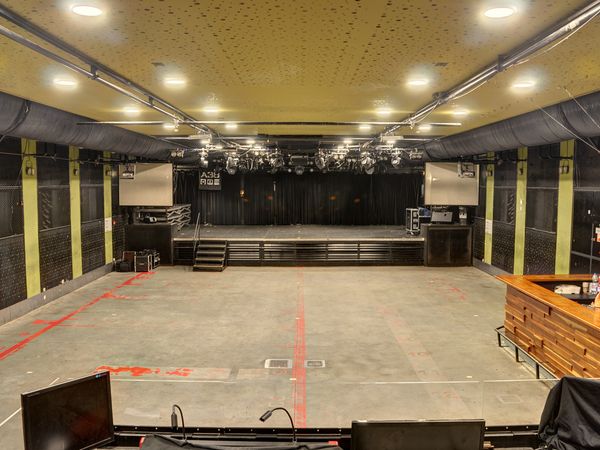
A38 Ship Club Stage - Budapest
A38 is a legendary concert venue situated on an old stone-carrier ship floating on the Danube river in Budapest. Its decent size and shape, the metallic walls and perforated ceiling design result in a unique acoustic space loved by many bands and artists that have performed here.

Baradla Cave Concert Hall - Aggtelek
This awe-inspiring underground concert hall inside the Baradla Cave, Hungary is part of the World Heritage by UNESCO since 1995. Its unique nature and the acoustic qualities in this one-of-a-kind concert hall results in an unforgettable listening and visual experience.

Church of St. Matthew - Anyksciai
Church of Apostle Evangelist St. Matthew is a red brick Neo-Gothic church in Anyksciai, Lithuania, situated on the right bank of the Sventoji River. The twin spires of the church, each 79 metres in height, make the church the tallest in Lithuania.

Berliner Philharmonie
The world famous Berliner Philharmonie was the very first \"vineyard-style\" concert hall built between 1960 and 1963. It has an asymmetrical tent-like shape with the stage at the center and with irregularly increasing row heights around it. The hall has exceptional acoustic qualities and sonic clarity.

Royal Concertgebouw - Amsterdam
The Royal Concertgebouw is unarguably one of the most prestigious concert halls in the world with extraordinary acoustics. Designed by Adolf Leonard van Gendt it was built between 1883 and 1888. The hall is 44 meters long, 28 meters wide, 17 meters high and seats more than 1900 people.

Johanneskirche - Darmstadt
The Neo-Gothic church was built according to plans by the Munich architect Heinrich von Schmidt under the direction of the church builder Karl Schwartze at the end of the 19th century and was rebuilt after being destroyed in the Second World War.

Underground Garage
A small sized, but quite reverberant underground garage located in the heart of Budapest office district. The irregular geometry of the space gives a pleasant diffuse feel to the acoustics.

Small Office
A typical small sized three person office with carpet floor, plastered brick walls furnished with office equipment.

Erkel Theatre - Budapest
Erkel is the largest theater in Hungary since it's opening in 1911. Having gone through notable renovation works in recent years, it can again fully function as the Hungarian State Opera's second performance venue seating more than 2400 people.

Festival Theatre of The Palace of Arts - Budapest
With its unique atmosphere and excellent sound properties provided by sound diffusing wood surfaces, the Festival Theatre is a popular venue for theatrical, dance, chamber music, jazz, world and pop music performances.

Bathroom #1
Medium sized bathroom of a family house with tiled floor and tiled walls.

Bedroom #1
Average sized bedroom of a family house with laminate floor and plastered brick walls.

Bedroom #2
A different average sized bedroom of a family house with laminate floor and plastered brick walls.

Vatroslav Lisinski Main Concert Hall - Zagreb
Vatroslav Lisinski Main Concert Hall is a large concert hall and convention center built between 1961 and 1973 in Zagreb, Croatia. The large single story audience area and the unique diffusors on the side walls give the space a one-of-a-kind acoustic character.

Vatroslav Lisinski Small Concert Hall - Zagreb
Vatroslav Lisinski Small Concert Hall is a concert hall and convention center with 305 seats in Zagreb, Croatia. The hall is named after Vatroslav Lisinski, the composer of the first Croatian opera, Love and Malice.

Basilica of St. Michael the Archangel - Marijampole
The basilica was built by the Congregation of Marian Fathers in 1824 and a Marian monastery has operated on the basilica grounds ever since. It was the de facto seat of the Diocese of Vilkaviskis when the cathedral in that city was destroyed during World War II.

Matthias Church - Budapest
Matthias Church is one of the most unique churches in Europe, located in Budapest, Hungary. The building was constructed in the florid late Gothic style in the 14th century and was extensively restored in the late 19th century. Its breathtaking, colorful interior and exotic atmosphere make it a perfect venue for choir and orchestra concerts. In 1987, the Matthias Church was honored with the status of World Heritage by the UNESCO World Heritage Committee.

Crypt of Matthias Church - Budapest
Underground crypt under the Matthias Church in Budapest. The shape of the room, the columns and the rustic surfaces result in a nice diffuse acoustic space with significanlty less reverberation than the main church itself.

Choir Rehearsal Room of Matthias Church - Budapest
A small sized, but extremely high ceiling rehearsal room on the gallery of the Matthias Church in Budapest. Thanks to the ceiling height, the room has a surprisingly long decay time despite its small footprint, which makes it ideal for choir rehearsals.

Studio No. 6 of The Hungarian Radio Corp. - Budapest
Studio No. 6 is a large sized recording room constructed in 1935 with the aim of performing large orchestral recordings. The acoustic designer of the room was Georg von Békésy, who was awarded the Nobel Prize for his acoustic researches in 1961.

Melbourne Town Hall
Since its completion in 1870, this magnificent, historic building designed by Joseph Reed, has served as the center of multiple cultural and civic events such as concerts, theatrical plays, exhibitions and many more in Melbourne, Australia.

Palace of Arts Concert Hall - Budapest
The Palace of Arts or Müpa Budapest is a cultural institution located in the capital of Hungary. Officially opened in 2005, its central space is the internationally acclaimed Béla Bartók National Concert Hall. With variable acoustics – including a 40-ton canopy above the stage and 48 pieces of reverberation chamber doors – it is deservedly placed among the very best halls in the world.

Orchestral Rehearsal Room
Large sized rehearsal room for symphonic orchestral usage with wooden floor, wood covered side walls and some raised platforms.

National Technical Library Textbooks Reading Room - Budapest
A medium sized reading room situated in the Central Library of the Budapest University of Technology and Economics. The high arched ceilings, the antique furniture and books add an impressive historic vibe to this functioning library visited by hundreds of students every day.

National Technical Library Main Reading Room - Budapest
The Central Library of the Budapest University of Technology and Economics has a history of 150 years. The currently used marvelous building was designed by the university's professor of architecture Samu Pecz. The impressive, cathedral-like Main Reading Room has already appeared in several well-known movies.

Hungarian State Opera
This neo-Renaissance style masterpiece designed by famed architect Miklos Ybl is one of Budapest's most impressive 19th century national monuments. The building's rich decoration and high-quality acoustics attract thousands of admirers of opera music each year.

The Scots' Church - Melbourne
The present neo-gothic church was designed by Joseph Reed and was opened in 1874, in Melbourne, Australia. The exterior of the church wasn't altered much in the following century while the interior was reorganized in 1930, when the splendidly carved stone pulpit and reredos were replaced. The interior reflects simplicity and restraint in design and decoration. The acoustics of the church provides exceptional clarity.

SkyCourt, Airport Passenger Hall - Budapest
SkyCourt is the passenger hall of Budapest International Airport Terminal 2A and 2B with gigantic windows, modern architectural solutions and a breathtaking view. The large volume of the space and the lack of sound absorbing surfaces make the hall extremely reverberant.

SkyCourt, Airport Cafeteria on the Gallery - Budapest
The gallery level of the SkyCourt passenger hall of Budapest International Airport with several different cafeterias, restaurants and shops. Since it is the gallery of the hall, the length of the reverb is almost as long as in the passenger hall.

Szechenyi Bath Entrance Hall - Budapest
This iconic, more than 100-year-old Neo-baroque palace was specifically designed for hosting Szechenyi Thermal Bath. It is not only the most popular thermal bath in Budapest but also one of the biggest natural hot spring spa baths in Europe. The large volume of the hall, the marble surfaces and the dome provide a rich and long reverberation to enjoy.

Szechenyi Bath Round Pool - Budapest
This iconic, more than 100-year-old Neo-baroque palace was specifically designed for hosting Szechenyi Thermal Bath. It is not only the most popular thermal bath in Budapest but also one of the biggest natural hot spring spa baths in Europe. The series of tiled halls all connecting together creates a lush reverb that envelopes the listener from all possible directions.

Votive Church - Szeged
The Szeged Votive Church, also known as the Szeged Dome, is the fourth biggest church in Hungary. It was designed by Frigyes Schulek and completed in 1930. Having pristine acoustics, it is ideal for choir and organ performances. Located near the river Tisza in the southern part of Hungary, the cathedral is the biggest in the region: 66 m in length and 33 m in height, with a capacity of approximately 5000 people.

Szimpla Pub Live Stage - Budapest
Szimpla Pub is a legendary and symbolic ruin pub located in the heart of Budapest. This open-air cinema and pub regularly hosts events such as live music, movie screenings, art galleries and even farmers’ markets.

Szimpla Pub Lobby - Budapest
Szimpla Pub is a legendary and symbolic ruin pub located in the heart of Budapest. This open-air cinema and pub regularly hosts events such as live music, movie screenings, art galleries and even farmers’ markets.

Basement Rehearsal Room
A typical small sized basement band rehearsal room with carpeted floor, concrete walls, and low ceiling height. The built in broadband absorbers and low frequency absorbers make the room quite dry.

Glass Hall of The Palace of Arts - Budapest
The Glass Hall is an exclusive conference area of the Palace of Arts in Budapest, with a remarkable view of the Danube and the Buda Hills. Its unique chandeliers glowing in a variety of colours make this place special. The Glass Hall regularly hosts banquets and in-house press conferences, while its acoustic characteristics also make it a great venue for chamber concerts.

Great Hall of the Liszt Academy of Music - Budapest
The renowned Great Hall of the Liszt Academy of Music – a university and a cultural institution founded in 1875 – plays a key role in the classical music life of Hungary. It underwent a major reconstruction in 2013. The measurements in the hall were taken shortly before the reconstruction, capturing the original sound of the venue.
| Variant | 1 |












